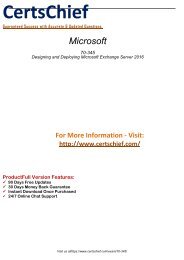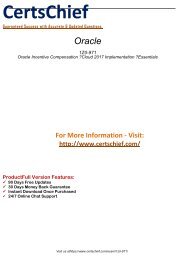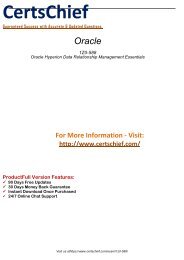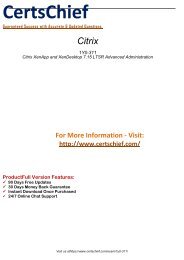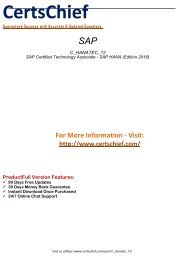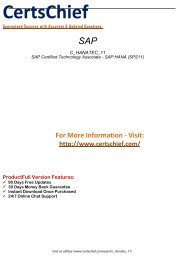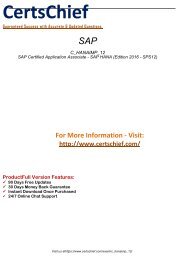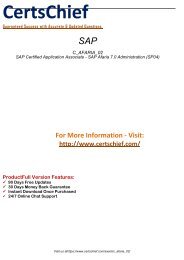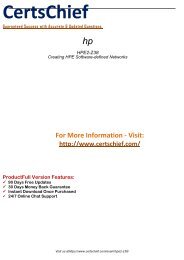70-463 Certification Test
Study kits and preparation materials provided by us for 70-463 Test are authorized by the professionals and industry experts. You can easily pass your certification test with our brain dumps and PDF sample questions. For more info please visit here: https://www.certschief.com/exam/70-463/
Study kits and preparation materials provided by us for 70-463 Test are authorized by the professionals and industry experts. You can easily pass your certification test with our brain dumps and PDF sample questions. For more info please visit here: https://www.certschief.com/exam/70-463/
Create successful ePaper yourself
Turn your PDF publications into a flip-book with our unique Google optimized e-Paper software.
CertsChief<br />
Guaranteed Success with Accurate & Updated Questions.<br />
Microsoft<br />
<strong>70</strong>-<strong>463</strong><br />
Implementing a Data Warehouse with Microsoft SQL Server 2012<br />
For More Information - Visit:<br />
http://www.certschief.com/<br />
ProductFull Version Features:<br />
90 Days Free Updates<br />
30 Days Money Back Guarantee<br />
Instant Download Once Purchased<br />
24/7 Online Chat Support<br />
Visit us athttps://www.certschief.com/exam/<strong>70</strong>-<strong>463</strong>/
Question: 1<br />
You are developing a project that contains multiple SQL Server Integration Services (SSIS) packages. The<br />
packages will be deployed to the SSIS catalog. One of the steps in each package accesses an FTP site to<br />
download sales transaction data.<br />
You create project parameters to store the username and password that are used to access the FTP site.<br />
You need to ensure that the username and password values are encrypted when they are deployed.<br />
What should you do?<br />
A. Set the Sensitive property of the parameters to True.<br />
B. Set the ProtectionLevel property of the package to EncryptSensitiveWithUserKey.<br />
C. Change the parameters to package parameters.<br />
D. Change the project to the Legacy Deployment model.<br />
Question: 2<br />
Answer: A<br />
You develop a SQL Server Integration Services (SSIS) package that imports SQL Azure data into a data<br />
warehouse every night.<br />
The SQL Azure data contains many misspellings and variations of abbreviations. To import the data, a<br />
developer used the Fuzzy Lookup transformation to choose the closest-matching string from a reference<br />
table of allowed values. The number of rows in the reference table is very large.<br />
If no acceptable match is found, the Fuzzy Lookup transformation passes a null value.<br />
The current setting for the Fuzzy Lookup similarity threshold is 0.50.<br />
Many values are incorrectly matched.<br />
You need to ensure that more accurate matches are made by the Fuzzy Lookup transformation without<br />
degrading performance.<br />
What should you do?<br />
A. Change the Exhaustive property to True.<br />
B. Change the similarity threshold to 0.55.<br />
C. Change the similarity threshold to 0.40.<br />
D. Increase the maximum number of matches per lookup.<br />
Explanation:<br />
http://msdn.microsoft.com/en-us/library/ms137786.aspx<br />
Question: 3<br />
Answer: B<br />
Visit us athttps://www.certschief.com/exam/<strong>70</strong>-<strong>463</strong>/
You install a SQL Server 2012 database engine instance on a production server. A month later, you install<br />
SQL Server 2012 Integration Services (SSIS).<br />
You must develop an SSIS project and deploy it to the server by using the Project Deployment model.<br />
Operations Log records that are outside the configured retention period must be cleaned automatically.<br />
You need to create the SSIS catalog on the production server.<br />
What should you do? (Each correct answer presents part of the solution. Choose all that apply.)<br />
A. Enable XP Command Shell.<br />
B. Enable CLR Integration.<br />
C. Enable OLE Automation.<br />
D. Start the SQL Server Browser service.<br />
E. Enable Cross Database Ownership Chaining<br />
F. Start the SQL Server Agent service<br />
G. Enable Ad Hoc Remote Queries.<br />
Explanation:<br />
Ref: http://msdn.microsoft.com/en-us/library/gg471509(v=sql.110).aspx<br />
Question: 4<br />
Answer: B, F<br />
DRAG DROP<br />
A SQL Server Integration Services (SSIS) package named DataFeed interacts with an external vendor data<br />
feed. The package is executed several times a day, either as part of other packages' control flow or by<br />
itself. The external data feed is unreliable because network failures and slow response times are<br />
frequent. The package is currently deployed on the file system.<br />
To analyze the reliability of the external data feed, you must collect execution data.<br />
Every time the DataFeed package is executed, the following information must be logged:<br />
Start Time<br />
End Time<br />
Execution Result<br />
Execution Duration<br />
You need to design a logging solution that meets the requirements by using the least amount of<br />
administrative and development effort.<br />
Which three actions should you perform in sequence? (To answer, move the appropriate actions from<br />
the list of actions to the answer area and arrange them in the correct order.)<br />
Visit us athttps://www.certschief.com/exam/<strong>70</strong>-<strong>463</strong>/
Answer:<br />
Explanation:<br />
Ref: http://msdn.microsoft.com/en-us/library/hh479592.aspx<br />
Question: 5<br />
A SQL Server Integration Services (SSIS) package on a computer is failing periodically in production. The<br />
package was created less than one year ago and was deployed to the SSIS catalog.<br />
Sometimes the package is started on a SQL Agent schedule; sometimes the package is started manually<br />
by an SSIS developer by using the Object Explorer in SQL Server Management Studio.<br />
You need to identify the authenticated user responsible for starting the package each time it failed in<br />
the past.<br />
Where can you find this information?<br />
A. the SQL Server Log<br />
B. the SSISDB.[catalog].[executions] view<br />
C. the SSISDB.[catalog].[event_messages] view<br />
D. the SQL Agent Job History<br />
E. the SQL Agent Error Log<br />
Question: 6<br />
Answer: B<br />
You maintain a SQL Server Integration Services (SSIS) package. The package was developed by using SQL<br />
Server 2008 Business Intelligence Development Studio (BIDS).<br />
The package includes custom scripts that must be upgraded.<br />
Visit us athttps://www.certschief.com/exam/<strong>70</strong>-<strong>463</strong>/
You need to upgrade the package to SQL Server 2012.<br />
Which tool should you use?<br />
A. SSIS Upgrade Wizard in SQL Server 2008 BIDS<br />
B. SSIS Upgrade Wizard in SQL Server Data Tools<br />
C. SQL Server DTExecUI utility (dtexecui.exe)<br />
D. SQL Server dtexec utility (dtexec.exe)<br />
Answer: B<br />
Question: 7<br />
DRAG DROP<br />
You are editing a SQL Server Integration Services (SSIS) package that contains a task with a sensitive<br />
property.<br />
You need to create a project parameter and configure it so that its value is encrypted when it is<br />
deployed to the SSIS catalog.<br />
Which three steps should you perform in sequence? (To answer, move the appropriate actions from the<br />
list of actions to the answer area and arrange them in the correct order.)<br />
Answer:<br />
DRAG DROP<br />
Question: 8<br />
Visit us athttps://www.certschief.com/exam/<strong>70</strong>-<strong>463</strong>/
A new SQL Server Integration Services (SSIS) project is deployed to the SSIS catalog.<br />
To troubleshoot some data issues, you must output the data streaming through several data flows into<br />
text files for further analysis. You have the list of data flow package paths and identification strings of<br />
the various task components that must be analyzed.<br />
You need to create these output files with the least amount of administrative and development effort.<br />
Which three stored procedures should you execute in sequence? (To answer, move the appropriate<br />
actions from the list of actions to the answer area and arrange them in the correct order.)<br />
Answer:<br />
Explanation:<br />
Ref: http://msdn.microsoft.com/en-gb/library/hh230989(v=sql.110).aspx<br />
Question: 9<br />
You are reviewing the design of an existing fact table named factSales, which is loaded from a SQL Azure<br />
database by a SQL Server Integration Services (SSIS) package each day. The fact table has approximately<br />
1 billion rows and is dimensioned by product, sales date, and sales time of day.<br />
The database administrator is concerned about the growth of the database. Users report poor reporting<br />
performance against this database. Reporting requirements have recently changed and the only<br />
Visit us athttps://www.certschief.com/exam/<strong>70</strong>-<strong>463</strong>/
emaining report that uses this fact table reports sales by product name, sale month, and sale year. No<br />
other reports will be created against this table.<br />
You need to reduce the report processing time and minimize the growth of the database.<br />
What should you do?<br />
A. Partition the table by product type.<br />
B. Create a view over the fact table to aggregate sales by month.<br />
C. Change the granularity of the fact table to month.<br />
D. Create an indexed view over the fact table to aggregate sales by month.<br />
Question: 10<br />
Answer: C<br />
You are designing a data warehouse with two fact tables. The first table contains sales per month and<br />
the second table contains orders per day.<br />
Referential integrity must be enforced declaratively.<br />
You need to design a solution that can join a single time dimension to both fact tables.<br />
What should you do?<br />
A. Create a time mapping table.<br />
B. Change the level of granularity in both fact tables to be the same.<br />
C. Merge the fact tables.<br />
D. Create a view on the sales table.<br />
Question: 11<br />
Answer: B<br />
You are designing a data warehouse for a software distribution business that stores sales by software<br />
title. It stores sales targets by software category. Software titles are classified into subcategories and<br />
categories. Each software title is included in only a single software subcategory, and each subcategory is<br />
included in only a single category. The data warehouse will be a data source for an Analysis Services<br />
cube.<br />
The data warehouse contains two fact tables:<br />
factSales, used to record daily sales by software title<br />
factTarget, used to record the monthly sales targets by software category<br />
Reports must be developed against the warehouse that reports sales by software title, category and<br />
subcategory, and sales targets.<br />
You need to design the software title dimension. The solution should use as few tables as possible while<br />
supporting all the requirements.<br />
What should you do?<br />
Visit us athttps://www.certschief.com/exam/<strong>70</strong>-<strong>463</strong>/
A. Create three software tables, dimSoftware, dimSoftwareCategory, and dimSoftwareSubcategory and<br />
a fourth bridge table that joins software titles to their appropriate category and subcategory table<br />
records with foreign key constraints. Direct the cube developer to use key granularity attributes.<br />
B. Create three software tables, dimSoftware, dimSoftwareCategory, and dimSoftwareSubcategory.<br />
Connect factSales to all three tables and connect factTarget to dimSoftwareCategory with foreign key<br />
constraints. Direct the cube developer to use key granularity attributes.<br />
C. Create one table, dimSoftware, which contains Software Detail, Category, and Subcategory columns.<br />
Connect factSales to dimSoftware with a foreign key constraint. Direct the cube developer to use a nonkey<br />
granularity attribute for factTarget.<br />
D. Create two tables, dimSoftware and dimSoftwareCategory. Connect factSales to dimSoftware and<br />
factTarget to dimSoftwareCategory with foreign key constraints. Direct the cube developer to use key<br />
granularity attributes.<br />
Question: 12<br />
Answer: C<br />
You are designing a data warehouse hosted on SQL Azure. The data warehouse currently includes the<br />
dimUser and dimDistrict dimension tables and the factSales fact table. The dimUser table contains<br />
records for each user permitted to run reports against the warehouse; and the dimDistrict table contains<br />
information about sales districts.<br />
The system is accessed by users from certain districts, as well as by area supervisors and users from the<br />
corporate headquarters.<br />
You need to design a table structure to ensure that certain users can see sales data for only certain<br />
districts. Some users must be permitted to see sales data from multiple districts.<br />
What should you do?<br />
A. Add a district column to the dimUser table.<br />
B. Partition the factSales table on the district column.<br />
C. Create a userDistrict table that contains primary key columns from the dimUser and dimDistrict<br />
tables.<br />
D. For each district, create a view of the factSales table that includes a WHERE clause for the district.<br />
Question: 13<br />
Answer: C<br />
You are reviewing the design of a customer dimension table in an existing data warehouse hosted on<br />
SQL Azure.<br />
The current dimension design does not allow the retention of historical changes to customer attributes<br />
such as Postcode.<br />
You need to redesign the dimension to enable the full historical reporting of changes to multiple<br />
customer attributes including Postcode.<br />
What should you do?<br />
Visit us athttps://www.certschief.com/exam/<strong>70</strong>-<strong>463</strong>/
A. Add StartDate and EndDate columns to the customer dimension.<br />
B. Add an IsCurrent column to the customer dimension.<br />
C. Enable Snapshot Isolation on the data warehouse.<br />
D. Add CurrentValue and PreviousValue columns to the customer dimension.<br />
Question: 14<br />
Answer: A<br />
You are implementing the indexing strategy for a fact table in a data warehouse. The fact table is named<br />
Quotes. The table has no indexes and consists of seven columns:<br />
• [ID]<br />
• [QuoteDate]<br />
• [Open]<br />
• [Close]<br />
• [High]<br />
• [Low]<br />
• [Volume]<br />
Each of the following queries must be able to use a columnstore index:<br />
• SELECT AVG ([Close]) AS [AverageClose] FROM Quotes WHERE [QuoteDate] BETWEEN<br />
'20100101' AND '20101231'.<br />
• SELECT AVG([High] - [Low]) AS [AverageRange] FROM Quotes WHERE [QuoteDate] BETWEEN<br />
'20100101' AND '20101231'.<br />
• SELECT SUM([Volume]) AS [SumVolume] FROM Quotes WHERE [QuoteDate] BETWEEN<br />
'20100101' AND '20101231'.<br />
You need to ensure that the indexing strategy meets the requirements. The strategy must also minimize<br />
the number and size of the indexes.<br />
What should you do?<br />
A. Create one columnstore index that contains [ID], [Close], [High], [Low], [Volume], and [QuoteDate].<br />
B. Create three coiumnstore indexes:<br />
One containing [QuoteDate] and [Close]<br />
One containing [QuoteDate], [High], and [Low]<br />
One containing [QuoteDate] and [Volume]<br />
C. Create one columnstore index that contains [QuoteDate], [Close], [High], [Low], and [Volume].<br />
D. Create two columnstore indexes:<br />
One containing [ID], [QuoteDate], [Volume], and [Close]<br />
One containing [ID], [QuoteDate], [High], and [Low]<br />
Explanation:<br />
Reference: http://msdn.microsoft.com/en-us/library/gg492088.aspx<br />
Reference: http://msdn.microsoft.com/en-us/library/gg492153.aspx<br />
Answer: C<br />
Visit us athttps://www.certschief.com/exam/<strong>70</strong>-<strong>463</strong>/
Question: 15<br />
You are designing an enterprise star schema that will consolidate data from three independent data<br />
marts. One of the data marts is hosted on SQL Azure.<br />
Most of the dimensions have the same structure and content. However, the geography dimension is<br />
slightly different in each data mart.<br />
You need to design a consolidated dimensional structure that will be easy to maintain while ensuring<br />
that all dimensional data from the three original solutions is represented.<br />
What should you do?<br />
A. Create a junk dimension for the geography dimension.<br />
B. Implement change data capture.<br />
C. Create a conformed dimension for the geography dimension.<br />
D. Create three geography dimensions.<br />
Question: 16<br />
Answer: C<br />
To facilitate the troubleshooting of SQL Server Integration Services (SSIS) packages, a logging<br />
methodology is put in place.<br />
The methodology has the following requirements:<br />
• The deployment process must be simplified.<br />
• All the logs must be centralized in SQL Server.<br />
• Log data must be available via reports or T-SQL.<br />
• Log archival must be automated.<br />
You need to configure a logging methodology that meets the requirements while minimizing the amount<br />
of deployment and development effort.<br />
What should you do?<br />
A. Open a command prompt and run the gacutil command.<br />
B. Open a command prompt and execute the package by using the SQL Log provider and running the<br />
dtexecui.exe utility.<br />
C. Add an OnError event handler to the SSIS project.<br />
D. Use an msi file to deploy the package on the server.<br />
E. Configure the output of a component in the package data flow to use a data tap.<br />
F. Run the dtutil command to deploy the package to the SSIS catalog and store the configuration in SQL<br />
Server.<br />
G. Open a command prompt and run the dtexec /rep /conn command.<br />
H. Open a command prompt and run the dtutil /copy command.<br />
I. Open a command prompt and run the dtexec /dumperror /conn command.<br />
J. Configure the SSIS solution to use the Project Deployment Model.<br />
K. Create a reusable custom logging component and use it in the SSIS project.<br />
Visit us athttps://www.certschief.com/exam/<strong>70</strong>-<strong>463</strong>/
Answer: B<br />
Explanation:<br />
Reference:<br />
http://msdn.microsoft.com/en-us/library/ms140246.aspx<br />
http://msdn.microsoft.com/en-us/library/ms180378(v=sql.110).aspx<br />
Question: 17<br />
You are developing a SQL Server Integration Services (SSIS) project that copies a large amount of rows<br />
from a SQL Azure database. The project uses the Package Deployment Model. This project is deployed to<br />
SQL Server on a test server.<br />
You need to ensure that the project is deployed to the SSIS catalog on the production server.<br />
What should you do?<br />
A. Open a command prompt and run the dtexec /dumperror /conn command.<br />
B. Create a reusable custom logging component and use it in the SSIS project.<br />
C. Open a command prompt and run the gacutil command.<br />
D. Add an OnError event handler to the SSIS project.<br />
E. Open a command prompt and execute the package by using the SQL Log provider and running the<br />
dtexecui.exe utility.<br />
F. Open a command prompt and run the dtexec /rep /conn command.<br />
G. Open a command prompt and run the dtutil /copy command.<br />
H. Use an msi file to deploy the package on the server.<br />
I. Configure the SSIS solution to use the Project Deployment Model.<br />
J. Configure the output of a component in the package data flow to use a data tap.<br />
K. Run the dtutil command to deploy the package to the SSIS catalog and store the configuration in SQL<br />
Server.<br />
References:<br />
http://msdn.microsoft.com/en-us/library/hh231102.aspx<br />
http://msdn.microsoft.com/en-us/library/hh213290.aspx<br />
http://msdn.microsoft.com/en-us/library/hh213373.aspx<br />
Question: 18<br />
Answer: I<br />
You are developing a SQL Server Integration Services (SSIS) package.<br />
To process complex scientific data originating from a SQL Azure database, a custom task component is<br />
added to the project.<br />
You need to ensure that the custom component is deployed on a test environment correctly.<br />
What should you do?<br />
Visit us athttps://www.certschief.com/exam/<strong>70</strong>-<strong>463</strong>/
A. Add an OnError event handler to the SSIS project.<br />
B. Open a command prompt and run the gacutil command.<br />
C. Configure the SSIS solution to use the Project Deployment Model.<br />
D. Open a command prompt and run the dtexec /dumperror /conn command.<br />
E. Configure the output of a component in the package data flow to use a data tap.<br />
F. Open a command prompt and execute the package by using the SQL Log provider and running the<br />
dtexecui.exe utility.<br />
G. Open a command prompt and run the dtexec /rep /conn command.<br />
H. Run the dtutil command to deploy the package to the SSIS catalog and store the configuration in SQL<br />
Server.<br />
I. Use an msi file to deploy the package on the server.<br />
J. Open a command prompt and run the dtutil /copy command.<br />
K. Create a reusable custom logging component and use it in the SSIS project.<br />
Reference:<br />
http://msdn.microsoft.com/en-us/library/ms403356.aspx<br />
Question: 19<br />
Answer: B<br />
DRAG DROP<br />
A SQL Server Integration Services (SSIS) project has been deployed to the SSIS catalog. The project<br />
includes a project Connection Manager to connect to the data warehouse.<br />
The SSIS catalog includes two Environments:<br />
Development<br />
QA<br />
Each Environment defines a single Environment Variable named ConnectionString of type string. The<br />
value of each variable consists of the connection string to the development or QA data warehouses.<br />
You need to be able to execute deployed packages by using either of the defined Environments.<br />
Which three actions should you perform in sequence? (To answer, move the appropriate actions from<br />
the list of actions to the answer area and arrange them in the correct order.)<br />
Visit us athttps://www.certschief.com/exam/<strong>70</strong>-<strong>463</strong>/
Answer:<br />
Question: 20<br />
You develop and deploy a SQL Server Integration Services (SSIS) package.<br />
The package is stored in the file system.<br />
You need to execute the package without importing it to the SSIS server.<br />
What should you use to execute the package? (Each correct answer presents a complete solution.<br />
Choose all that apply.)<br />
A. catalog.start_package<br />
B. dtexec<br />
C. SQL Server Management Studio<br />
D. SQL Server Agent<br />
Explanation:<br />
Ref: http://technet.microsoft.com/en-us/library/ms141<strong>70</strong>8(v=sql.110).aspx<br />
Answer: B, D<br />
Visit us athttps://www.certschief.com/exam/<strong>70</strong>-<strong>463</strong>/
Powered by TCPDF (www.tcpdf.org)<br />
For More Information - Visit:<br />
http://www.certschief.com/<br />
20% Discount Coupon Code:<br />
20off2016<br />
Visit us athttps://www.certschief.com/exam/<strong>70</strong>-<strong>463</strong>/<br />
http://www.certschief.com/exam/0B0-104/<br />
Page | 1







